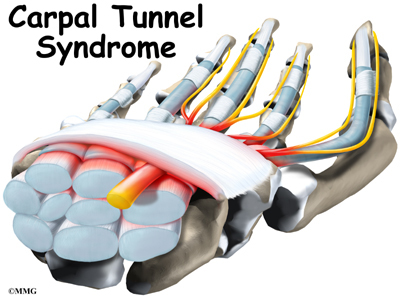
This strange-sounding problem has nothing to do with the kind of tunnels you drive through. When someone has carpal (say: kar-pul) tunnel syndrome, or CTS, the "tunnel" of bones
and ligaments in their wrist has narrowed. This narrowed tunnel pinches a nerve, causing a tingly feeling or numbness in a person's hand, especially in the thumb and first three fingers.
Someone with carpal tunnel syndrome may have trouble typing on the computer or playing a video game. In fact, repetitive motions (doing the same thing again and again) from those activities may be to blame for causing the carpal tunnel syndrome in the first place.
Where Is This Tunnel?
Take a look at the palm of your hand. Under the skin at your wrist is the tunnel we're talking about. Nine tendons (tough bands of tissue that join a muscle with some other part of the body) and one nerve pass through this tunnel from the forearm to the hand. The bottom and sides of the carpal tunnel are formed by wrist bones, and the top of the tunnel is covered by a strong band of connective tissue called a ligament.
The tendons that run through the tunnel connect muscles to bones and help you use your hand and bend your fingers and thumb. The nerve that passes through the carpal tunnel to reach the hand is the median (say: me-dee-un) nerve.
It's pretty tight inside the carpal tunnel. In fact, there's barely enough room for the tendons and the nerve to pass through it. If anything takes up extra room in the canal, the median nerve gets pinched, which causes numbness and tingling in the area of the hand where the nerve spreads out. Swelling can occur when someone does the same thing over and over, like typing. This swelling can pinch the nerve.
Who Gets It?
Millions of Americans have CTS. Kids can get it, too, but it's not as common. Most people who get CTS are over 30, and more women than men have it. In fact, three times as many women as men have CTS. Computer operators, assembly-line workers, and hair stylists are at risk because they repeat the same hand movements over and over again.
What Causes It?
Anything pressing on the median nerve can cause CTS. The tendons passing through the carpal tunnel can become swollen from doing the same movement over and over, like typing on a computer or playing video games or a musical instrument for long periods of time. It's more common in gymnasts, particularly those who do a lot of handstands, and in people who play racquet sports, like tennis.
Broken or dislocated wrist bones or even sprains that cause swelling around the carpal tunnel may lead to CTS, too. Medical problems that increase someone's risk of getting CTS include arthritis, thyroid problems, and diabetes. CTS is also more common during pregnancy and in people who are overweight.
How Is It Diagnosed and Treated?
Did you ever wake up and your hand is still asleep — all numb and giving you pins and needles? That's what it can feel like to have CTS. One way to tell if you have CTS is to check if your pinky is also numb. It won't be in a person with CTS. A doctor who suspects CTS will listen to the person's symptoms and then do a wrist examination. By tapping on the person's wrists, the doctor is often able to tell whether the problem is CTS.
A brace or splint can help mild cases of CTS. It is usually worn at night and keeps a person's wrists from bending. Keeping the wrist straight opens the carpal tunnel so the nerve has as much room as possible. Resting the wrist will allow the swollen tendons to shrink. Medicines like ibuprofen can also help reduce the swelling.
In more severe cases, your doctor may recommend cortisone (say: kor-tih-zone) to reduce inflammation and swelling in the carpal tunnel. This medicine is given by a shot, or injection. When the symptoms of CTS have improved, the doctor may suggest the person do wrist exercises and make changes that can prevent further problems, such as repositioning the computer and keyboard.
If none of these treatments help, the person may need surgery to release the pressure on the median nerve. This surgery takes less than an hour and usually doesn't require a stay overnight in the hospital. Very few people are permanently injured by CTS. Most can get better and take steps to prevent the symptoms from returning.
CTS Prevention
Though not many kids get CTS, it's a good idea to develop good habits now that can prevent this problem in adulthood. When you spend a lot of time on the computer, be sure to take breaks and not overdo it. Just getting up to stretch or do something else for a while can help. You might even set an alarm clock or a kitchen timer to go off every hour or so to remind you to take your breaks.
At the computer, be sure your work area is comfortable. Use a chair that can be adjusted for your height so that you aren't sitting down too low or up too high. Your chair, computer screen, and keyboard should all be in line. And try to follow these rules while sitting:
- Hold your elbows at your sides with your wrists in front to set the keyboard height.
- Keep your forearms and wrists straight and don't bend your wrists up.
- If you use a wrist pad, don't press into it when you type.
- Place things you use a lot within close reach, with no item farther than an arm's length away.
When you take these steps, you're treating your wrists just right. And if you ever get CTS, remember that there's always light at the end of the carpal tunnel.